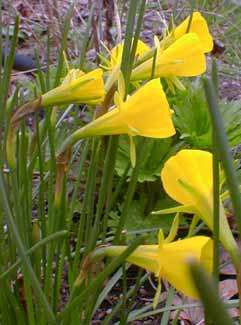
Hoop Petticoat Daffodils
Daffy-down dilly has come to town
In a yellow petticoat & a green gown.
-Mother Goose
The daffodil I am most fond of is the descriptively named Hoop Petticoat Daffodil (Narcissus bulbocodium conspicuus, the variant or subspecies name often wrongly "corrected" to conspicuous).
Granny Artemis bought potted starts for the garden in spring of 2002 & they bloomed through April. They showed themselves much better the following year, blooming by the start of the second week in March. In Autumn 2003 We also obtained bulbs for a named variety, "Golden Bells," planted in Autumn 2003, in the same general area.
This expanding drift of this Award of Garden Merit botanical daffodil is near the picket fenceline between a Japanese Maple & a Black Pussywillow, both of which are leafless when the Hoop Petticoats most require a lot of sun.
The species is native of Spain & southern France & usually stays at about a foot height. Though preferring a warm setting it can adjust to climates down to USDA Zone 5, some winter mulch helping them through the winter.
The slender very grass-like leaves appear in February in colder climates, but here in the moderate micro-climate of Puget Sound, its slender grass is showing itself by late September & gets thicker & nicer month by month throughout autumn & winter. The area where they are planted should be well marked, as it would be terribly easy to mistake its reemergence as an invasion of turf & yank it out, but once familiar with its apperance, its rigidly upright threads of deep sea green form a very ornamental winter grass, appearing a little later than the floppy autumn grass of spring-blooming Muscari botryoides grape hyacinths.
It can bloom as early as the second week in February, though only tepidly if that early. It is at its flowery best mid to late March & persists through much of April, the longest-blooming of our miniature daffodils. It looks vastly more natural, like a true wildflower, than do full-size daffodils, which we don't grow because they'd contradict the woodland flavor of our garden paths.
They are not picky as to soils. It prefers sun but tolerates some shade; it likes our naturally acidic soils but would do well in neutral to slightly alkaline soil. They want moderately moist soils but overwatering can do them in. This European native will usually naturalize in the garden, & will pop up for many years to come.
There are other variants of N. bulbocodium including N. b. obesum with wider-open hoops, & N. b. tenuifolius with slenderer hoops. There are a handful of hybridized cloned cultivars, including a group of white hoop petticoats called Nylons which though having varied hybrid histories cannot be told apart so are not named as distinct cultivars, though most are likely hybrids of N. catabricus with the sundry subspecies or variants of N. bulbocodium. We planted exactly one Nylon bulb in autumn 2003.
Some other species with this hoopskirt appearance are occasionally available from bulb specialists, usually at pretty high prices per bulb. These include the pale-pale yellow N. praecox paucinervis, teency sulfer-yellow N. romieuxii, creamy yellowish white N. albidus zaianicus & N. albidus foliosus, all from North Africa but somewaht adaptable in cooler climates, as is the pure white N. antabricus from Spain. There are others, all native to Mediterranean regions. All of these are more fragile than the most tried & true N. bulbocodium, & are comparatively rare in the nursery trade, but eventually I'll be attempting to grow any others that are at least marginally hardy.